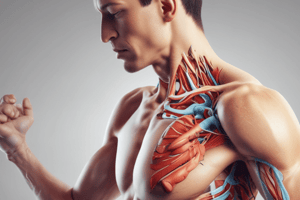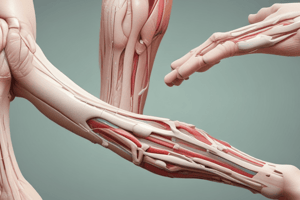Podcast
Questions and Answers
Match the following descriptions with the correct condition related to the elbow:
Match the following descriptions with the correct condition related to the elbow:
Results in swelling and tenderness of the olecranon bursa = Olecranon bursitis Point tenderness at the lateral epicondyle or along the grooves of the olecranon process = Epicondylitis Increased pain with pronation and supination of the elbow = Epicondylitis Cushion between the skin and the olecranon process = Olecranon bursa
Match the following elbow range of motion movements with their expected degrees:
Match the following elbow range of motion movements with their expected degrees:
With the elbow fully extended at 0 degrees, bend and straighten the elbow = Flexion of 160 degrees and extension returning to 0 degrees or 180 degrees of full extension With the elbow flexed at a right angle, rotate the hand from palm side down to palm side up = Pronation of 90 degrees and supination of 90 degrees
Match the following shoulder inspection findings with their associated conditions:
Match the following shoulder inspection findings with their associated conditions:
Asymmetric shoulder contour with hollows in one shoulder = Shoulder dislocation Outward prominence of the scapula indicating nerve injury = Winged scapula
Match the following anatomical structures with their descriptions in relation to shoulder inspection:
Match the following anatomical structures with their descriptions in relation to shoulder inspection:
Match the following muscle evaluation instructions with their purpose in assessing elbow strength:
Match the following muscle evaluation instructions with their purpose in assessing elbow strength:
Match the following joints with their associated bones and ligaments:
Match the following joints with their associated bones and ligaments:
Match the following movements with the corresponding degrees of range of motion:
Match the following movements with the corresponding degrees of range of motion:
Match the following structures with their locations and functions:
Match the following structures with their locations and functions:
Match the following hand deformities with their descriptions:
Match the following hand deformities with their descriptions:
Match the following terms with their corresponding descriptions:
Match the following terms with their corresponding descriptions:
Match the following hand swellings with their descriptions:
Match the following hand swellings with their descriptions:
Match the following hand movements with their descriptions:
Match the following hand movements with their descriptions:
Match the following exam findings with their anatomical locations or actions:
Match the following exam findings with their anatomical locations or actions:
Match the following thumb movements with their descriptions:
Match the following thumb movements with their descriptions:
Match the following hand motions with their descriptions:
Match the following hand motions with their descriptions:
Match the following terms with their definitions:
Match the following terms with their definitions:
Match the following terms with their descriptions:
Match the following terms with their descriptions:
Match the following terms with their symptoms:
Match the following terms with their symptoms:
Match the following conditions with their characteristics:
Match the following conditions with their characteristics:
Match the following joints with their associated deformities:
Match the following joints with their associated deformities:
Match the following elbow range of motion movements with their expected degrees:
Match the following elbow range of motion movements with their expected degrees:
Match the following hand strength evaluation techniques with their corresponding actions:
Match the following hand strength evaluation techniques with their corresponding actions:
Match the following elbow inspection findings with their implications:
Match the following elbow inspection findings with their implications:
Match the following terms related to elbow conditions with their descriptions:
Match the following terms related to elbow conditions with their descriptions:
Match the following muscle evaluation instructions with their purpose in assessing elbow strength:
Match the following muscle evaluation instructions with their purpose in assessing elbow strength:
Match the following terms with their corresponding definitions: (A) Heberden nodes, (B) Bouchard nodes, (C) Olecranon bursitis, (D) Rheumatoid nodule
Match the following terms with their corresponding definitions: (A) Heberden nodes, (B) Bouchard nodes, (C) Olecranon bursitis, (D) Rheumatoid nodule
Match the following descriptions with their corresponding images: (A) Metacarpophalangeal flexion and hyperextension, (B) Finger flexion: thumb to each fingertip and to the base of the little finger, (C) Finger abduction, (D) Wrist radial and ulnar movement
Match the following descriptions with their corresponding images: (A) Metacarpophalangeal flexion and hyperextension, (B) Finger flexion: thumb to each fingertip and to the base of the little finger, (C) Finger abduction, (D) Wrist radial and ulnar movement
Match the following terms with their related actions: (A) Telescoping digits with hypermobile joints, (B) Degenerative joint disease, (C) Unexpected findings of the fingers, (D) Rheumatoid arthritis involving the elbow
Match the following terms with their related actions: (A) Telescoping digits with hypermobile joints, (B) Degenerative joint disease, (C) Unexpected findings of the fingers, (D) Rheumatoid arthritis involving the elbow
Match the following actions with their corresponding angles: (A) Flexion of wrist, (B) Hyperextension of wrist, (C) Extension of fingers, (D) Radial movement of wrist
Match the following actions with their corresponding angles: (A) Flexion of wrist, (B) Hyperextension of wrist, (C) Extension of fingers, (D) Radial movement of wrist
Match the following movements with their descriptions: (A) Proximal interphalangeal joints, (B) Radiocarpal groove and wrist, (C) Range of motion of hand and wrist, (D) Palpation of olecranon process grooves
Match the following movements with their descriptions: (A) Proximal interphalangeal joints, (B) Radiocarpal groove and wrist, (C) Range of motion of hand and wrist, (D) Palpation of olecranon process grooves
Match the following conditions with their pathophysiology: Abnormal narrowing of the spinal canal
Match the following conditions with their pathophysiology: Abnormal narrowing of the spinal canal
Match the following findings with their associated conditions: Swollen joint with shiny red skin
Match the following findings with their associated conditions: Swollen joint with shiny red skin
Match the following conditions with their patient data: Pain radiating to arms, weakness of thumb
Match the following conditions with their patient data: Pain radiating to arms, weakness of thumb
Match the following pathophysiologies with their patient data: Bone necrosis due to decreased blood flow
Match the following pathophysiologies with their patient data: Bone necrosis due to decreased blood flow
Match the following abnormalities with their descriptions: Inflammation of the bursa
Match the following abnormalities with their descriptions: Inflammation of the bursa
Match the following conditions with their objective data: Tophi under the skin with chronic form
Match the following conditions with their objective data: Tophi under the skin with chronic form
Match the following pathophysiologies with their patient data: Compression within flexor tendon sheath
Match the following pathophysiologies with their patient data: Compression within flexor tendon sheath
Match the following abnormalities with their descriptions: Hot swollen joint with limited range of motion
Match the following abnormalities with their descriptions: Hot swollen joint with limited range of motion
Match the following patient data with their conditions: Pain that radiates down legs.
Match the following patient data with their conditions: Pain that radiates down legs.
Match the following pathophysiologies with their objective data: Decreased blood flow leading to bone necrosis.
Match the following pathophysiologies with their objective data: Decreased blood flow leading to bone necrosis.
Flashcards are hidden until you start studying




